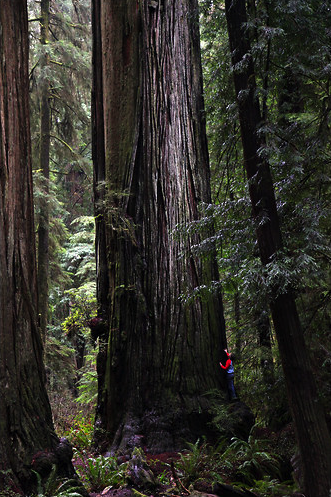Stewart Brand's Blog, page 103
May 6, 2011
Long Now Media Update

LISTEN
(downloads tab)
Tim Flannery's "Here on Earth"
There is new media available from our monthly series, the Seminars About Long-term Thinking. Stewart Brand's summaries and audio downloads or podcasts of the talks are free to the public; Long Now members can view HD video of the Seminars and comment on them.







May 5, 2011
Aspen Environment Forum 02011
The Aspen Environment Forum is a three day conference produced by the Aspen Institute and the National Geographic Society. Held this year from May 30th through June 2nd, the forum "will provide a critical framework for committed voices to address a significant milestone: A global population of 7 billion and how to reconcile Earth's finite resources with its ability to sustain our expanding human needs."
This year's speakers include Sylvia Earle, Andrew Revkin, Bill McKibben, and Long Now's own Stewart Brand.
Here's a highlight from 2009 (check out more video highlights here) featuring Nature Conservancy lead scientist M. Sanjayan:
General passes to the Aspen Environment Forum cost $1,500, but Long Now Members have been offered a discounted price – members can send an email to services@longnow.org for more information.







May 4, 2011
Tim Flannery, "Here on Earth"
Wallace beats Darwin
A Summary by Stewart Brand
The great insight of natural selection was published simultaneously by Charles Darwin and Alfred Russell Wallace in 1858, Flannery pointed out, but their interpretations of the insight then diverged.
Darwin's harsh view of "survival of the fittest" led too easily to social Darwinism, eugenics societies, neo-classical economics, and an overly reductionist focus on the "selfish gene." Wallace, by contrast, focused on the tendency of evolution to generate…
Read the rest of Stewart Brand's Summary here.







April 29, 2011
Breathing New Life into Old Trees
Being in the presence of a really old tree–think 1,000 years or more–inspires awe and, hopefully, an elongating of temporal perspective. Your thoughts are led away from the familiar concerns of yesterday, today and tomorrow, and the lifespan of the tree gradually comes into focus. The rise and fall of cities and scientific paradigms become more relevant than the rise and fall of hairstyles and political buzzwords. And perhaps the younger trees nearby grew from seeds produced by that aged individual. Or, with the help of the Archangel Ancient Tree Archive, perhaps the seedling in your backyard is that aged individual.
The Archangel Ancient Tree Archive, highlighted recently in the New York Times, seeks out the very oldest and largest living individuals of several different tree species–including coastal redwoods and giant sequoias–and clones them. The purpose? Reforestation and genetic archiving. Co-founder David Milarch sees trees as key to the health of water and soil systems. As the New York Times article put it, he "preaches his love for all things arboreal with an evangelical zeal." Fair enough. Trees play an important role in their ecosystems, just like all parts of any ecosystem do. So why collect the oldest trees? Archangel's website provides two distinct reasons for this, which seem to stem from the two goals of reforestation and archiving. On the one hand, reforestation efforts benefit from old trees' "demonstrated longevity."
The trees that we collect from have coped with the margins of life in their long life span, and in that they will have the greatest health and ability to survive. As they are introduced back into the environment, the seedlings from these trees will have the greatest survivability when planted.
It should be noted, however, that genetics are not the only reason that some trees live longer than others. A tree's supply of water or sunshine can shepherd it to longevity, and the assertion that seedlings from ancient trees will exhibit superior performance because their DNA "is essentially a memory for surviving calamity" borders on the Lamarckian. Archangel's idea for a genetic archive renders a much more interesting perspective, and an interesting format as well: the archive's 'data' (plant DNA) will be stored by clones of the original specimens in groves of living trees, with multiple clones of the same tree growing in various locations so as to avert losing data to a single natural disaster.
We are preserving the best known genetics to give ourselves a chance at something that could be great and something we will learn about for generations to come.
…If we allow these very old trees to tip over and die, we will never have the opportunity to study those genetics in the future to understand why they were able to make it so long and get so big.
…What Archangel is doing is difficult, but we believe in the long run this work will be very valuable.
Regardless of whether or not the genes from these "very old trees" turn out to be any different from the average member of the species, the forward-thinking what-ifs here are laudable. Archangel is taking something awesome and making it available to future generations, recognizing that their knowledge and research methods will most likely be more capable than ours in unexpected ways. It's not just about preserving trees, it's about preserving options. And besides…what better thing to copy than a forty-story tall redwood?







April 28, 2011
Long Now Media Update

WATCH
Ian Morris's "Why the West Rules – For Now"
There is new media available from our monthly series, the Seminars About Long-term Thinking. Stewart Brand's summaries and audio downloads or podcasts of the talks are free to the public; Long Now members can view HD video of the Seminars and comment on them.







April 27, 2011
The Warren Buffett-hedge fund bet tightens

Warren Buffett and (l to r) Protégé Partners' Scott Bessent, Jeffrey Tarrant, and Ted Seides.
In 02008, Warren Buffet placed a Long Bet that will take until 02017 to resolve. He predicted that for those ten years, "the S & P 500 will outperform a portfolio of funds of hedge funds, when performance is measured on a basis net of fees, costs and expenses."
Below is a summary of how things went in the third year of this Bet, as published by Fortune Magazine:
April 26, 2011 5:00 am
Berkshire Hathaway's chairman won the 2010 race for investment returns, but Protégé Partners retains the long-term lead.
By Carol Loomis, senior editor-at-large
FORTUNE — We're three years into Warren Buffett's 10-year bet with the hedge fund community, and the race has narrowed. For the second year in a row, Buffett's horse in the contest — an S&P 500 index fund — did better than the average return booked by five funds of hedge funds picked by Protégé Partners LLC, a New York money-management firm.
The Protégé pack, though, built up a big lead in the first year of the bet, the financially torturous 2008, and is still ahead.
This contest, to look back briefly, began when Berkshire Hathaway (BRKA) chairman Buffett, no fan of the transaction and management fees that cut the returns of hedge fund investors, said publicly in 2006 that in a long-term bet he'd back an S&P index fund against hedge funds. Ted Seides, a Protégé partner, picked up the idea, and a bet was negotiated.
The Protégé camp may be out front, but that is not to say either side has done well: Neither is in the black for three years. In a sense, the only winners in this bet so far are the managers of the funds of funds, who've been paid fees even if their investors have lost money.
In the wicked start-off year, 2008, Vanguard's Admiral shares — the index fund carrying Buffett's colors — fell by a dismal 37%, and Protégé's picks had an average loss of "only" 24%.
In the next year, 2009, the S&P index gained 26.6% to the funds' 16%. And last year's results — being announced here for the first time — showed the S&P rising by 15% vs. the funds gaining, on average, 8.5%.
The three-year record, therefore, puts the Protégé funds of funds in the lead with a loss of 4.2%, against the S&P's even greater loss of 8.18%.
The year-by-year results display unsurprising patterns: Given the ability of hedge funds to sell short and invest in financial instruments other than stocks, they are the odds-on favorite in a bad year for the market — a 2008, for example — than the long-only S&P. Conversely, in a good year for the market, when many funds may continue to hedge with part of their assets, the S&P has the advantage.
Followers of this bet will remember that the names of the five funds of funds have never been disclosed — though Protégé itself runs funds of funds and the biggest of these, called Protégé Partners LP, may be assumed to be among the five.
Another reminder: The stake is $1 million — so to speak, because there's a present-value factor built into the bet. At its start, each side put up $320,000, with the total going to buy a zero-coupon bond that will be worth $1 million when the 10-year competition is over. That money is to go to the charity that each side designated at the outset. (Buffett's charity is Girls Inc. of Omaha; Protégé's is Absolute Return for Kids).
The party holding the zero-coupon bond is the Long Now Foundation of San Francisco, whose wish to promote long-term thinking led it to set up a mechanism called Long Bets. On its site, www.longbets.org, you can read the predictions that various prognosticators have made about who will win the Buffett-Protégé contest.
There are no recent posts because Long Bets ran into a spam problem and for a time wouldn't accept comments. It will take them now, though — so you're invited to weigh in.
The writer of this article is a longtime friend of Warren Buffett's and the editor of his chairman's letter in the Berkshire annual report.







April 26, 2011
Last Typewriter Factory Closes
After selling only 800 models last year – down from over 10,000 as recently as 02009 – the last typewriter factory in the world (according to The Daily Mail) has closed its doors and halted production. The factory was run by Godrej and Boyce and was based in Mumbai, India. The majority of the typewriters being produced in the last few years were for writers of Arabic in countries where modern PCs have yet to fully penetrate the market.
Despite the demise of industrial production, it seems likely the typewriter will live on. Kevin Kelly once said technologies are immortal and if the collector/maintainer culture that's already going strong around typewriters is any indication, manually thwacking ink onto paper has a good run ahead of it yet:
For the real, restored thing there's myTypewriter.com
Rarotype Inc. in Sunrise, Florida still manufactures printwheels for use in manual typewriters of many different brands.
Mr. T pities the early-adopting fool: "With a typewriter from MrTypewriter.com you can rest assured that you have invested in a quality machine that has been fully tested and restored to once again provide many years of reliable service for today's wordsmiths. "
You can live in a typewriter factory in Emerson, IL.
Check out these USB Typewriters for giving your iPad that vintage feel.
The Early Office Museum explores the history of typewriters.
IBM has an online timeline describing their contributions to typewriter technology.
(Sent in by Katie Malone – thanks!)







April 25, 2011
The Library of Utility

I imagine a library atop a remote mountain that collects the essential information needed to re-learn practical knowledge essential to civilization. This depot, open to anyone who journeys there, is the cultural equivalent of the Svalbard seed bank, a vault on the Arctic Circle that holds frozen seeds of crop plants from around the world. The utilitarian documents in this vault would be the seeds of culture, able to sprout again if needed. It would be the Library of Utility, and it would serve as civilization's backup.

Most great libraries of today have a broad mandate to be very inclusive. They contain "everything." This everything is being duplicated in digital form by Google and others as the long-desired Universal Library. But the library at the top of the mountain would be different. It would be a very selective library. It would not contain the world's great literature, or varied accounts of history, or deep knowledge of ethnic wonders, or speculations about the future. It has no records of past news, no children's books, no tomes on philosophy. It contains only seeds. Seeds of utilitarian know-how. How to recreate the infrastructure and technology of civilization so far. The library would gather the knowledge needed to recreate itself — all the mechanical structures of brick, mortar, glass — the library itself. One could think of it as a manual for making a physical library with books and paper. Or a manual for reconstruction the infrastructure of civilization. A civilization reboot manual, which has also been discussed at the Long Now Foundation and in various science fiction stories. From the seeds of know-how archived here you could regrow the arts of printing, or metalworking, or plastics, or plywood, or laser discs.
This information is not usually found in libraries, or in books, or even on the web in text. These days much instructional and utilitarian information is conveyed in YouTube clips. Partly because video is a good way to show how something is done, but also because it is much easier to record a video that put things into words and diagrams. But often that ease lowers the quality of instruction. If you had to rely on a university library to find instructions on how to make sheet metal from ore, or even to find and extract the ore, or to make plastic from oil, or to grow silicon to make make a chip, it would be very difficult. Usually such utilitarian knowledge is missing from books, but even when it is present in the library, it is dilute and spread throughout many books or journals. A lot of this utilitarian knowledge is implicit knowledge and passed along outside of written documentation. And when written down, these documents are often not the type to find their way into libraries.
It need not be a giant library. It may be possible to fit all the essential information needed to bootstrap the infrastructure of civilization into 10,000 books or so. And unlike the Universal Library of Google, it would be on paper. In a century or so, paper-based books will be rare. But paper books will outlast any digital platform and paper requires the least amount of technology to access. Paper will be universally readable at any period. You can't say that about floppy disks, CD-Roms, and PDFs.
But rather than containing merely shelves of books, this Library of Utility would contain sequences of books. Depending on where you wanted to start, you would visit different documents. If you already knew how to make glue, you could immediately start the instructions on making plywood. But if you did not know how to make water-proof glue, you would begin at a different point. Or if you knew glue and wood spinning, but did not know about hydraulic presses, you'd get a different set of instructions. That multi-forking seems pretty hypertext; would not digital be better for this? Yes, it would be better, but would be done in paper as a back up.
Perhaps the Library of Utility is usually sealed airtight, say through the winter, and it is opened a few times, or a few months, a year for adding books and research. This is a 10,000-year Library, encased in an impermeable shell that could last for hundreds of years without human attention if it came to that. So the Library of Utility would be built to house the most essential 10,000 books for 10,000 years, a library of practical knowledge that could be bootstrapped to restart civilization at any point it might be needed.
There is no need to wait for the Library to be built at the top of the mountain. It could be started now, in any garage. What books would you bring to it if you could?
(The image on top is of small monastery in the Himalayas, near Paro, Bhutan. There were only a few books in it. The second image is of the Svalbard seed bank. No books, only seeds.)
This article was cross posted from The Technium.







April 19, 2011
SALT Speaker Tim Flannery's "Here on Earth" iPad app
Ecologist Tim Flannery is on tour in the US to support his recently released Here on Earth: A Natural History of the Planet, a book that explores the intertwined histories of humanity and planet Earth.
On May 3rd, he'll discuss Here on Earth at one of Long Now's Seminars About Long-term Thinking in San Francisco. Long Now Members who can't make it in person can listen to a live audio stream of the event as it happens.
In addition to the print version of Here on Earth, Flannery and his publishing team created an iPad app that comes with the full text of the book, 60 minutes of original film and animated content, interactive maps and infographics and an integrated Twitter-based reading group that allows readers to see what others are saying about the book in real-time.
Tim Flannery is a best-selling and prolific author of natural histories; a professor of paleontology, paleoclimatology & mammology; and the Chairman of the Copenhagen Climate Council. Some of his previous works include The Weather Makers and The Eternal Frontier.







April 18, 2011
Live Audio Streaming for the Seminars About Long-term Thinking

For over seven years, Long Now has been producing the monthly Seminars About Long-term Thinking in San Francisco. The series was started in order to build a compelling body of ideas about long-term thinking and through those ideas, to help nudge civilization toward our goal of making long-term thinking automatic and common instead of difficult and rare.
Long Now Foundation Members attend these lectures for free, and over the years, it has been encouraging to see a community develop around hearing, discussing, critiquing and implementing this body of ideas. As our membership has grown, however, so has its geographic distribution and we now have members in many countries all over the world.
In order to better serve our further afield supporters, we're introducing Live Audio Streaming of the Seminars for Members of The Long Now Foundation.
Using time and bandwidth donated by Stream Guys (thanks!), we're able to provide live streaming audio of the speaker's talk. Additionally, a service called CoverItLive allows us to share the presentation slides and provide a forum to discuss the lecture in real-time with other Members. Through this interface, Members can also submit questions for the speaker and follow discussion of the event on Twitter.
Our next Seminar features Australian ecologist Tim Flannery on May 3rd and if you can't make it in person – no sweat! Just tune in to longnow.org/live at 7:00 PM PST and join the conversation!







Stewart Brand's Blog
- Stewart Brand's profile
- 291 followers









